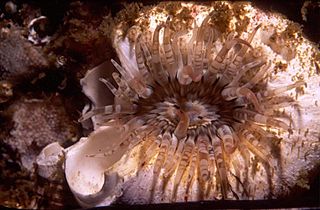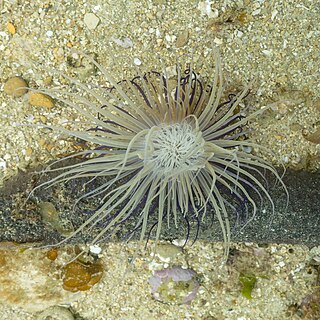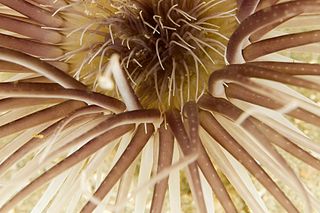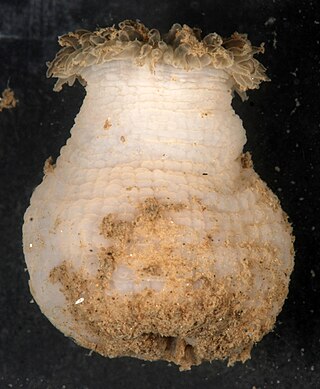
Anthozoa is a class of marine invertebrates which includes the sea anemones, stony corals and soft corals. Adult anthozoans are almost all attached to the seabed, while their larvae can disperse as part of the plankton. The basic unit of the adult is the polyp; this consists of a cylindrical column topped by a disc with a central mouth surrounded by tentacles. Sea anemones are mostly solitary, but the majority of corals are colonial, being formed by the budding of new polyps from an original, founding individual. Colonies are strengthened by calcium carbonate and other materials and take various massive, plate-like, bushy or leafy forms.

Tube-dwelling anemones or ceriantharians look very similar to sea anemones but belong to an entirely different class of anthozoans. They are solitary, living buried in soft sediments. Tube anemones live inside and can withdraw into tubes, which are composed of a fibrous material made from secreted mucus and threads of nematocyst-like organelles known as ptychocysts. Within the tubes of these ceriantharians, more than one polyp is present, which is an exceptional trait because species that create tube systems usually contain only one polyp per tube. Ceriantharians were formerly classified in the taxon Ceriantipatharia along with the black corals but have since been moved to their own class, Ceriantharia.

Sea anemones are a group of predatory marine invertebrates constituting the order Actiniaria. Because of their colourful appearance, they are named after the Anemone, a terrestrial flowering plant. Sea anemones are classified in the phylum Cnidaria, class Anthozoa, subclass Hexacorallia. As cnidarians, sea anemones are related to corals, jellyfish, tube-dwelling anemones, and Hydra. Unlike jellyfish, sea anemones do not have a medusa stage in their life cycle.
The brooding anemone, Halianthella annularis, is a species of sea anemone in the family Halcampidae,.

Anthostella stephensoni, the violet-spotted anemone, is a species of sea anemone in the family Actiniidae.

Anthopleura michaelseni, commonly known as the long-tentacled anemone or crevice anemone, is a species of sea anemone in the family Actiniidae. It is native to very shallow water round the coasts of southern Africa between Lüderitz and Durban.

Korsaranthus natalensis, commonly known as the spinnaker anemone or the candy-striped anemone, is a species of sea anemone in the family Actiniidae. It is the only member of its genus.

The ring-tentacle anemone is a species of sea anemone in the family Isanthidae.

The Cape zoanthid is a species of zoanthid in the family Parazoanthidae.
Cerianthus lloydii is a species of tube-dwelling sea anemone in the family Cerianthidae. It is sometimes called the lesser cylinder anemone and is found in shallow seas around the coasts of north west Europe.

Ceriantheopsis is a genus of tube-dwelling anemones in the family Cerianthidae. Members of the genus are found only in the Atlantic Ocean. They are predators, scavengers and omnivores.

Balanophyllia bonaespei is a species of solitary cup coral, a stony coral in the family Dendrophylliidae. It is an azooxanthellate species that does not contain symbiotic dinoflagellates in its tissues as most corals do.

Cerianthus membranaceus, the cylinder anemone or coloured tube anemone, is a species of large, tube-dwelling anemone in the family Cerianthidae. It is native to the Mediterranean Sea and adjoining parts of the northeastern Atlantic Ocean.

Ceriantheomorphe brasiliensis is a species of tube-dwelling anemones in the family Cerianthidae. It is found in the tropical western Atlantic Ocean, the Caribbean Sea and the Gulf of Mexico. It is currently listed as endangered based on a lack of evidence.

Ceriantheopsis americana is a species of tube-dwelling anemone in the family Cerianthidae. It is a burrowing species and lives in deep sand or muddy sand in a long slender tube that it creates.

Haloclava producta is a species of sea anemone in the family Haloclavidae, commonly known as the ghost anemone. This species is native to shallow water in the northwestern Atlantic Ocean, between Cape Hatteras and the Bay of Fundy, where it makes a temporary burrow in soft sediment. It is found on sand flats, both intertidally and subtidally.

Paranthus rapiformis, the onion anemone, is a species of sea anemone in the family Actinostolidae. It was first described by the French naturalist Charles Alexandre Lesueur in 1817 and is native to the northwestern Atlantic Ocean and the Gulf of Mexico.

Metridium dianthus is a species of sea anemone in the family Metridiidae. It is found in the northern Atlantic Ocean and in the northeast Pacific Ocean. There is also a record from South Africa, possible resulting from an introduction.
The Goukamma Marine Protected Area is an inshore conservation region near Knysna in the Western Cape province in the territorial waters of South Africa

Anthopleura artemisia is a species of sea anemone. It is known by a number of common names, including burrowing anemone and moonglow anemone. It was first described to science in 1846 in a volume by James Dwight Dana, reporting on the animals found on the United States Exploring Expedition. Dana attributes the description to Charles Pickering, who was a naturalist on the expedition.


















